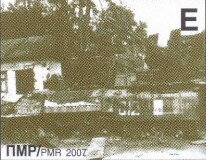Stamp: 15th Anniversary of the Bendery Tragedy (Transnistria 2007)
15th Anniversary of the Bendery Tragedy (Transnistria 2007)
19 June (Transnistria ) within release 15th Anniversary of the Bendery Tragedy goes into circulation Stamp 15th Anniversary of the Bendery Tragedy face value E No Face Value
| Stamp 15th Anniversary of the Bendery Tragedy in catalogues | |
|---|---|
| Colnect codes: | Col: MD-PMR 2007.06.19-01a |
Stamp is square format.
Stamp from souvenir sheet.Also in the issue 15th Anniversary of the Bendery Tragedy:
- Stamp - 15th Anniversary of the Bendery Tragedy face value E;
- Stamp - 15th Anniversary of the Bendery Tragedy face value E;
- Stamp - 15th Anniversary of the Bendery Tragedy face value K;
- Stamp - 15th Anniversary of the Bendery Tragedy face value K;
- Stamp - 15th Anniversary of the Bendery Tragedy face value E;
- Stamp - 15th Anniversary of the Bendery Tragedy face value Д;
Stamp 15th Anniversary of the Bendery Tragedy it reflects the thematic directions:
An anniversary is the date on which an event took place or an institution was founded in a previous year, and may also refer to the commemoration or celebration of that event. For example, the first event is the initial occurrence or, if planned, the inaugural of the event. One year later would be the first anniversary of that event. The word was first used for Catholic feasts to commemorate saints. Most countries celebrate national anniversaries, typically called national days. These could be the date of independence of the nation or the adoption of a new constitution or form of government. The important dates in a sitting monarch's reign may also be commemorated, an event often referred to as a "Jubilee".
Commemorations are a type of religious observance in the many Churches of the Anglican Communion, including the Church of England. They are the least significant type of observance, the others being Principal Feasts, Principal Holy Days, Festivals, and Lesser Festivals. Whereas Principal Feasts must be celebrated, it is not obligatory to observe Commemorations. They are always attached to a calendar date, and are not observed if they fall on a Sunday, in Holy Week, or in Easter Week. In Common Worship Commemorations are not provided with collects or indications of liturgical colour. However, they may be celebrated as Lesser Festivals if local pastoral conditions suggest it.
A disaster is a serious problem that happens over a period of time and causes so much harm to people, things, economies, or the environment that the affected community or society cannot handle it on its own. In theory, natural disasters are those caused by natural hazards, whereas human-made disasters are those caused by human hazards. However, in modern times, the divide between natural, human-made or human-accelerated disasters is more and more difficult to draw. In fact, all disasters can be seen as human-made, due to human failure to introduce appropriate emergency management measures



